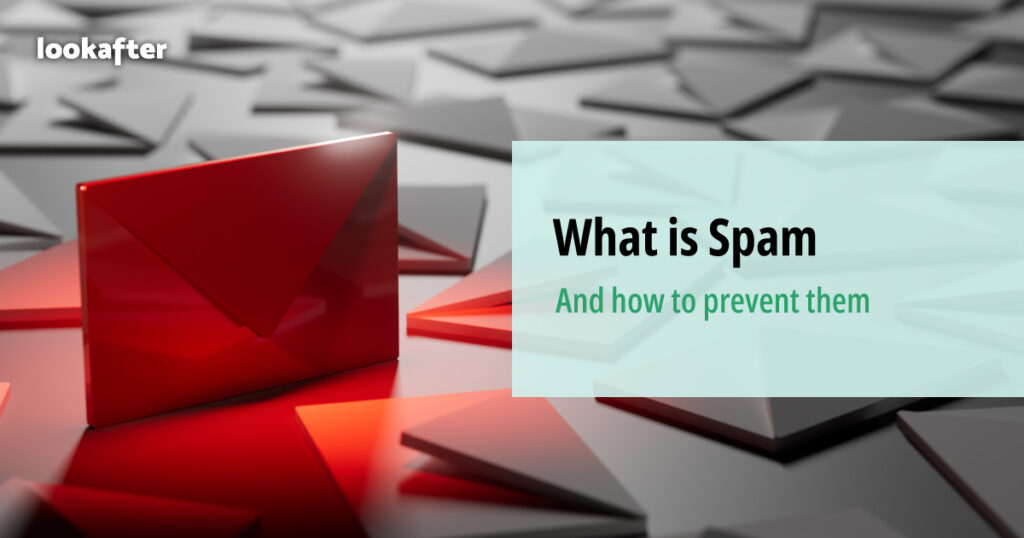Home > Empowering Tips > Spam – What is it and how to prevent them

Have you ever received emails like an advertisement of a product that you never ask for, or emails from unknown senders with deals that are too good to be true? All these emails – sent to you without your consent – are typically spam mails.
Spam mails often appear harmless, but some of them can contain threats like malicious attachments, phishing scams or fraudulent offers that attempt to infect your device with malware, hack into your account, or steal your sensitive information.
Fortunately, there are several ways you can do to reduce and prevent spam mails. Keep reading to find out more.
What is spam?
A spam mail, also known as junk mail, is an unsolicited message sent in bulk. The person who sends spam mail is known as a spammer, while the act of sending spam is called spamming.
Spammers can be real humans, but more often, they are botnets, which is a network of Internet-connected devices that are infected with malware.
Why do people send out spam?
We usually think of spammers as hackers who aim to hijack someone’s account or device, or scammers who try to solicit money or information. But as unethical and unprofessional as spam mails may be perceived, there are legitimate businesses who use it for commercial purposes.
The reason why spam mail is so viable is its cost effectiveness. Any senders can send out mass quantity of emails with zero to a very low cost. Imagine getting a profit of RM1 for each response. If they send out 10 million spams, even if there is only 0.01% response, they are already earning RM1,000!
Why am I getting spam mails?
You receive spam mails because your email address has fallen into the hands of spammers.
There are various methods spammers can use to obtain your email address and then send you spam mails:
- Dictionary harvest attack. Through this attack, spammers try to find valid email addresses by randomly sending emails to common mailbox names for a domain, such as info@yourdomain.com. An email address is reckoned valid if the receiving email server did not reject the email.
- Social media sites or public records. It is easy for spammers to obtain your email address if it is posted online on social media sites (e.g. LinkedIn and Facebook), public forums or websites.
- Buying email lists. Spammers may have purchased a list of email addresses from legal or illegal sources that contain your email address.
- Data breach. Your email address could have been exposed to spammers if an individual or company that has that information was a victim of data breach.
- Newsletter subscription. You could have intentionally or unintentionally subscribed to a newsletter or mailing list that gave out your email address.
- Malware infection. Your computer could have been infected with a malware or virus that exposes your personal information, including email address and passwords, to spammers.
How to prevent spam
You can prevent spam with the following tips and tricks.
- Don’t respond to spam. When you receive a spam mail, don’t click links, don’t download attachments, and don’t reply the spammer. The links and attachments may contain viruses that could harm your device. In addition, if you respond to the spam mail, the spammer may mark you as a valid recipient and send you even more spams.
- Don’t open suspicious-looking email or attachment. Emails that come from unknown senders or contain suspicious content and attachment are likely spam mails. Spammers may implant harmful viruses within the email message or attachment, which could infect your computer if it is opened or downloaded.
- Use spam or junk filter. Many webmail applications or email clients come with a spam filter feature that automatically moves spam mails to your spam or trash folder.
- Report or block spam mails. When you identify a spam mail, report it to your email administrator, or black list the spammer email address so that you won’t get spam mails from the same spammer again.
- Keep your email address private. Avoid publishing your email address online. Only provide it to people you know or trust.
- Use a contact form on your website. Instead of posting your email address on your website, using a contact or enquiry form is a safer alternative.
- Avoid using common usernames in email address. Common email names like info, sales, contact and enquiry are easy targets for spammers, because they are very easy to be harvested or guessed.
- Use alternate email address to sign up for free or one-time services. Avoid using primary email address to subscribe for such services.
- Keep your device clean of malware and viruses. Make it a habit to regularly scan your computer with anti-virus to keep it clear from malware. Always ensure that your security tools and firewalls are updated with the latest patches to guard against security threats that could expose your personal details to spammers.